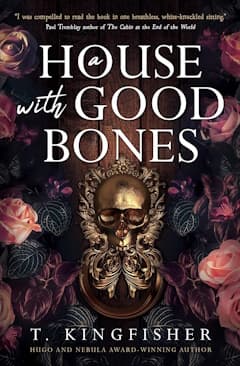
A House with Good Bones by T. Kingfisher
(Titan Books, 2023)
Reviewed by Susan Peak
T. Kingfisher, the author, also writes as Ursula Vernon. As Ursula Vernon, she writes children’s graphic novels, notably the Dragonbreath series, while as T. Kingfisher she writes adult horror fiction. Her 2020 book, The Twisted Ones, won the Dragon award for Best Horror Novel. This book is described as US Southern Gothic; it is creepy but doesn’t tip over into full-on horror. I found it to be an engaging book, well written, with distinct characters and a strong storyline. At 259 pages it’s easily read in one sitting.
The story is set in North Carolina, in an ordinary subdivision (a village, from the context), with fairly new houses that are becoming somewhat dilapidated—this helps to set the atmosphere. Samantha Montgomery is the protagonist, coming back to the family home when there is a break in the archaeological dig she is involved with. The Gothic element starts promptly with a vulture on the mailbox of her mother’s home; the vulture theme continues throughout the book.
The book is told in the first-person with a lot of narrative which lets the reader visualise both the protagonist and the setting. Both a humorous undertone and a hint of a sinister family background are shown early. Sam self-describes as fat and is humorous about that (“There aren’t many social advantages to being fat, but I’ll give it this, nobody ever thinks you are a cat burglar.”). She also has a most unusual job: she’s an archaeoentomologist. This is used well in the book when there is a plague of ladybirds. Sam has been scientifically trained, and also has a sceptical mindset, these come into play when strange things start to happen. Sam possibly also has ADHD although it’s never clear, and I thought this added to the characterisation—she takes herself for granted.
The other key character in the book is Sam’s mother, on whom the effects of the strange events are shown well: her health suffers, for example, with weight loss and mental confusion, and Sam wonders if she is starting to develop dementia. She’s clearly terrified, that terror affecting every aspect of how she behaves, including dramatically changing the interior decoration of the house, but it takes Sam some time to overcome her own scepticism and realise what it is her mother is afraid of. This, it turns out, is her grandmother—her mother’s mother—who is early on shown to be a nasty character. Interestingly, she turns out to have been being nasty for an at least partly good reason—a nicely ambiguous touch.
There are only a few characters in this story—Sam, her mother and grandmother, and two minor characters—but that adds to the claustrophobic atmosphere of the book. The two minor characters—Phil, a handyman, and Gail, a helpful neighbour, who seems to have a link with the vultures—are also well written and engaging.
The book has quite a prolonged buildup to the truly Gothic climax, and I was torn between thinking this was too long, and thinking that, actually, it suited the setting and Sam’s character very well. One niggle I did have was with how often Sam dismisses her own concerns—certainly, the strange happenings would be disconcerting to a scientist, but would a scientist also keep dismissing those incidents as often as Samantha is shown as doing? However, her internal conflict is very well illustrated through the first-person narrative. I found the ending very satisfying, when Sam has to call on previously unsuspected depths within her. This works because it is handled very much in the context of her character and the setting.
Anyone who already reads T. Kingfisher or Ursula Vernon’s books will enjoy this, as will readers who enjoy Gothic and borderline horror stories.
Review from BSFA Review 22 - Download your copy here.
